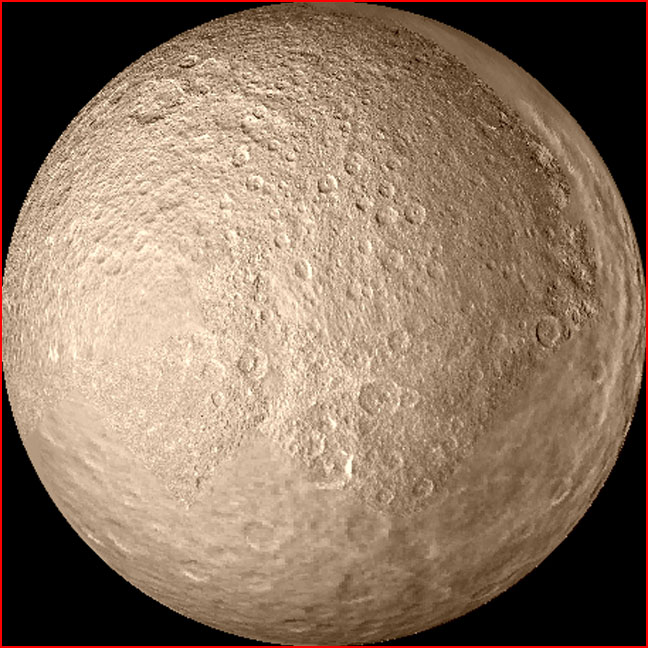
home •
about •
essential guide •
picture of the day •
thunderblogs •
news •
multimedia •
predictions •
products •
get involved •
contact
picture of the day archive subject index
Saturn's moon Rhea. Credit: NASA/JPL
Jul 27, 2007
Rhea the Battered Ice BallSaturn's moon Rhea exhibits a vast complex of craters. On closer examination the craters pose repeated challenges to common theory.
Rhea is another of Saturn's moons that bears examination in light of electrical theories. Rhea's mean diameter is 1528 kilometers, so it is medium-sized in Saturn's family of moons. Even though it is so small, the entire visible surface of Rhea is covered in craters. One large "impact basin" is 360 kilometers across, which probably makes it the most cataclysmic event in the moon's history, considering anything larger would have blasted it to rubble.
One of the most interesting features of Rhea is the large, bright splotch that covers almost one entire hemisphere. Because it resembles the rayed structures found on Earth's moon, scientists have attributed its formation to an asteroid explosively hurling subsurface debris outward in long ejecta blankets. As previous Thunderbolts Picture of the Day articles have noted, however, rayed formations are more likely to be the result of electric arcs and not impacts.
The rays surrounding the large central crater are not deep but look more like a thin layer of dust without the gradual sizing of the granules as they recede from the point of impact. They were probably deposited by an "electric wind" as the plasma arc reduced the surface rocks to fine powder and then floated it away as ionized particles. The bright rays on Rhea appear to have been created in the same way.
Cassini's initial flyby in 2004 discovered two craters with unusual formations in their centers. Nearly all craters on Rhea occur in multiples, the majority of the larger ones are in pairs with many smaller craters distributed around them non-randomly. A surprising aspect to their arrangement is that they are found on the rims of the large craters, corresponding to what happens in electric discharge machining (EDM) when a spark will "stick" to one spot for a split second, carving small craters as the main discharge rotates within the large one. The two peaks in the centers of the craters are another example of EDM. It is highly unlikely that an impact of a space rock could ever create such a formation. In fact the typical shallow, flat floors of the craters, together with central bumps, provide a perfect match with the pattern produced by plasma physicist C J Ransom in his laboratory arcing experiments.
Another eye catching feature on Rhea is an oval-shaped crater approximately 115 kilometers on its longest axis. The conventional explanation is that it was formed when a meteor at some remote time, billions of years ago, struck the moon and scooped out the crater along its direction of travel. If that explanation is accurate, then where is the gouge that should be at the bottom? Why is the leading rim not built up from the movement of rock and ice as the meteor exploded through it at a shallow angle? And why is the crater -and all the craters surrounding it - flat on the interior with sharp, perpendicular walls? If they were made by meteor impacts, shouldn't they be rounded and have raised lips?
These are only a few of many huge structures that indicate Rhea did not undergo a slow, steady formation out of a nebular cloud, but probably moved through rapidly evolving conditions as electric arcs tore its surface. What has been left behind is the record of those conditions in the form of fractures, chaotic terrain and gigantic caldera as big as the state of Oregon, but with no debris.
Despite what appears to be explosions large enough to rock the planet, there are no fragments - no big boulders or blocks of stone that would be expected from explosive impacts. If the craters and rilles were formed by giant electric arcs, then the rock and ice was probably vaporized or turned into tiny grains and thrown into space.
By Stephen Smith
___________________________________________________________________________Please visit our Forum
The Electric Sky and The Electric Universe available now!

|
|

|
EXECUTIVE EDITORS:
David Talbott, Wallace Thornhill
MANAGING EDITORS:
Steve Smith, Mel Acheson
CONTRIBUTING EDITORS: Michael Armstrong, Dwardu Cardona,
Ev Cochrane,
C.J. Ransom, Don Scott, Rens van der Sluijs, Ian Tresman
WEBMASTER: Brian Talbott
Copyright 2007: thunderbolts.info
![]()
home •
thunderblogs •
forum •
picture of the day •
resources •
team •
updates •
contact us

